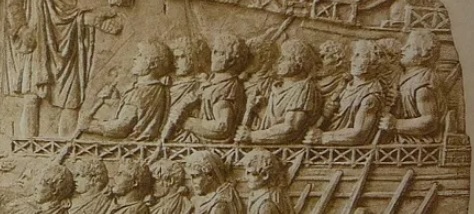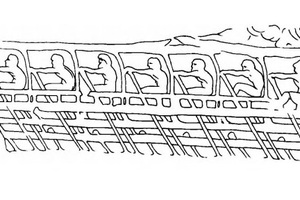Trireme
The trireme (triremis) was, without exaggeration, the most common warship of antiquity. Despite its size, it possessed formidable combat power. The ship's primary weapon was the rostrum—a ram located at the bow. However, some reliefs depict triremes with superstructures equipped with various types of missile-launching machines.
 Trajan's Column, Rome.
Trajan's Column, Rome.
Dimensions of the Ship
The exact dimensions of the trireme are not definitively known. In the book by Bannikov and Morozov, History of the Roman and Byzantine Navy (p. 75), several versions are provided: the ship's hull could vary in length from 35 to 40–42 meters, and its width from 5.5 to 8 meters. The ship was also equipped with two masts. Under sail, it could reach speeds of up to 8 knots (approximately 14.8 km/h). When rowed, this speed decreased to 5 knots (almost 10 km/h).
Crew
The full crew of the trireme exceeded 200 men, with 170 of them being rowers arranged in three tiers. The rowers were commanded by the Hortator remigium, who was responsible for coordinating the rowers' efforts, setting the rowing rhythm, maintaining discipline, and distributing food. In addition to the rowers, the trireme carried a small contingent of marines, commanded by a centurion, and a few sailors who managed the ship's sails.
Command Structure
Overall command of the ship was held by the Triarch—the ship's captain. He was assisted by the helmsman, known by the Romans as the gubernator. Another crew member, the Proret, was responsible for plotting the course and navigating the ship, and was positioned at the bow.
Other team members
In addition to the sailors, military and command staff, the ship had a certain number of specialists. For example, there was a carpenter (materiarius), a healer, a rope maker and a greaser of leather cuffs for oars (history of the fleet of Rome and Byzantium, p. 78). The lower tier of oars was covered with cuffs to prevent water from entering the ship. However, in the event of a ramming blow to the side, it was the rowers of the lower tiers who were the first to die. Appian describes how rowers of the lower tiers (thalamites) drown, while rowers of the upper tiers manage to escape (App., BC, V, 107).
In addition to the sailors, marines, and officers, the ship also had several specialists on board. For example, there was a carpenter (materiarius), a physician, a rope specialist, and a lubricator for the leather cuffs of the oars (History of the Roman and Byzantine Navy, p. 78). The lower tier of oars was sealed with cuffs to prevent water from entering the ship. However, in the event of a ramming strike to the side, the rowers on the lower tiers were the first to perish. Appian describes how the lower-tier rowers (Thalamites) drowned, while the upper-tier rowers managed to escape (App., BC, V, 107).
Related topics
Rostrum, Sternpost, Aplustre, Triarch, Siege Engines, Composition of the Ancient Roman Navy



